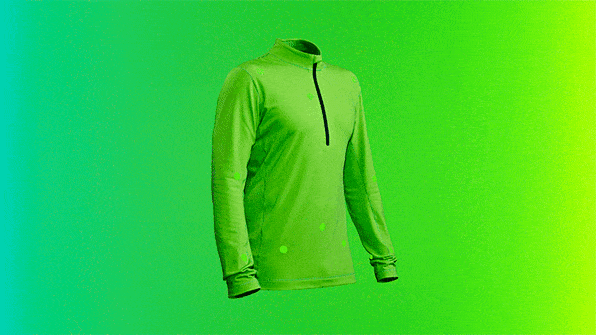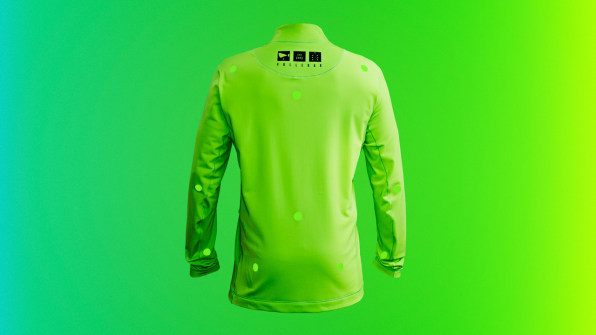Pedestrian or cyclist, it’s the world’s most visible hue.
Thousands of pedestrians and bike riders are hit by cars every year in a terrible trend that’s only growing. It’s a problem of our infrastructure, but the best defense can simply be making yourself as visible to drivers as possible. Which is why the young athletic wear brand Vollebak is designed specifically to stand out.
Vollebak, the same company that brought us a pink hoodie designed for maximum relaxation, is launching something new: The Nano Meter 555 Midlayer, which features two details that hack human perception to make you, theoretically, as noticeable as possible.
“The project started as a series of conversations with mountain rescue, members of the U.K. Special Forces, and World Extreme Medicine–men and women who work in some of the most remote and harshest places on the planet. Asked to describe what they would want someone to be wearing in an ideal rescue situation they wanted something that made them as visible as humanly possible to the naked eye,” says co-founder Steve Tidball. “Interestingly, it wasn’t about creating a high-tech solution for them, because technology can fail. It was all about color and human perception.”
The jacket is green, but not just any green. It’s a green that reflects with a 555-nanometer wavelength, which, according to the U.K. National Physics Laboratory, is the point at which the greatest number of cones of your eye are stimulated the most. Over a year of development and prototyping dyes and materials, the team tried to get this jacket as close to 555 as possible.

The color looks a lot like one that Nike was pushing around the 2016 Olympics, famously worn by the world champion female gymnastics team on the podium. “While there may be other people using similar colors, we don’t know of anyone going to the same lengths or exploring the idea in this kind of way,” says Tidball of competitors. “And as color isn’t patentable (apart from in a few very exceptional circumstances) we’re not looking to own this green, we’re just trying to use it in the most effective way.”

The second perceptual optimization? Reflective dots that, when applied to the jacket, work much the same way a motion capture system digitizes human movement.

The research stems from Sweden scientists in the 1970s. “By attaching small lights to people’s elbows, hips, and other joints, and filming them walking and climbing, they showed that just eight points of light on the front of a torso surrounded by darkness were enough to enable us to accurately perceive three-dimensional human motion. In other words, we can tell we’re looking at a person, as well as what direction they’re moving and at what speed,” says Tidball. “After a series of our own experiments we opted for 10 dots on the front and 10 dots on the back of our mid layers. When you take an idea out of a lab you have things like bag straps to contend with, folds in material, and athletes moving in highly unpredictable ways. Of course, you could always add more dots, but we’re always looking for the smartest and most efficient answer.” The reflective dots allow a human figure to be spotted, in otherwise total darkness, in a quarter of a second.
So is that faster than a blinking light on a bike? Or any old reflective garment you might wear? Frankly, who knows. But even still, one can appreciate the academic design that went into the garment (which, by the way, is also available in black if the green is too cloying), and the fact that form follows function. The mid layers are available now for $195.
–
This article first appeared in www.fastcodesign.com
Seeking to build and grow your brand using the force of consumer insight, strategic foresight, creative disruption and technology prowess? Talk to us at +9714 3867728 or mail: info@groupisd.com or visit www.groupisd.com



